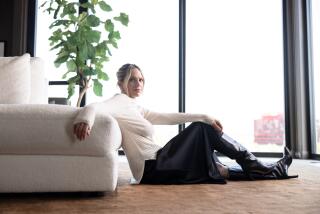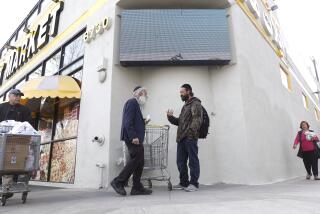Celebrating Jewish Life : New Skirball Museum’s Goal Is to Reflect Old and New of Proud Culture
BRENTWOOD — The museum shop shelves were bare and the track lights still needed adjustment, but one thing at the Skirball Cultural Center and Museum was set in stone: “Go forth . . . and be a blessing”--words from the Torah carved into a granite wall near the exhibit entrance.
The 125,000-square-foot Skirball complex is striving to be just that, with not only museum space but also a conference center and classrooms.
“I think we would misrepresent the place if we just called it a museum,” said Skirball President Rabbi Uri D. Herscher, preparing for the museum’s opening to the public at 1 p.m. Sunday.
The museum’s core is a permanent exhibition titled “Visions and Values: Jewish Life from Antiquity to America.” Selected from its collection of 25,000 objects--one of the two largest such collections in the United States--the exhibit begins by tracing Jewish history around the globe. A second section focuses on the Jewish experience in the United States.
“The impetus was to celebrate that intersection--the intersection of the 4,000-year-old Jewish story with the nearly 400-year-old [American] Jewish story,” said Herscher, “to emphasize that we are both an old and new people.”
The center had an earlier incarnation as the Skirball Museum on the campus of Hebrew Union College, south of downtown Los Angeles. In 1981, the college’s board of governors approved the cultural center project, with the provision that no construction start until the center had in hand 70% of the $65 million needed for it.
Work did not get underway on the site--15 acres on the west side of the San Diego Freeway in Sepulveda Pass just south of Mulholland Drive--until 1990.
The Skirball was incorporated as a nonprofit institution last year, but--as required by the board of governors--the completed project is debt-free, said Herscher, and has $15 million toward a desired $25-million endowment.
Seed money came from Jack and Audrey Skirball. Ten years after being ordained as a rabbi, Jack Skirball became a film producer, and later a real estate investor. He also served as the founding chairman of the board of overseers for Hebrew Union. More than 400 other families also made contributions, said Herscher.
The Skirball Center takes its place among a number of ethnic-specific museums in Los Angeles, including the Japanese American National Museum and California Afro-American Museum. Museum Director Nancy M. Berman said the challenge facing all such institutions is to draw in patrons from outside their own ethnic communities.
Herscher envisions the Skirball as a place where divergent ethnic groups can convene, he said. In addition to ample courtyard space, the center has a conference room that can seat 400, a 350-seat auditorium and four classrooms. Already the Skirball has hosted one conference on gay rights and another on American values.
Another part of that outreach will be a full slate of educational and cultural events. Program Director Robert Kirschner said the Skirball has plans for several film series, starting with one showing American-Jewish comedies this fall. Next spring he hopes to start a concert music series.
The center also has a discovery center, designed to teach children about biblical archeology.
Kirschner said the Skirball will begin continuing education classes in the fall and is investigating the possibility of offering lessons in English as a second language and citizenship.
“This is a place that celebrates the immigrant experience, that says immigrants are good for America,” Kirschner said.
Indeed, the second half of the permanent exhibition starts with a ceiling-high replica of the torch from the Statue of Liberty and replicas of the benches at Ellis Island. Early Jewish life in America mirrors the experience of most immigrant groups, Herscher said.
Unlike the Museum of Tolerance in West Los Angeles or the Holocaust Museum in Washington, D.C., the Skirball does not focus on the death of 6 million Jews during World War II. The Holocaust is not overlooked, but is presented as one chapter in a 4,000-year history. Examination of Jewish life so often focuses on the mournful, Herscher said, instead of the joyful and hopeful.
“The best revenge for the dark periods of Jewish history is an institution that assures everyone that we are alive,” Herscher said. “And the quality of our lives is determined by what we give back to our communities.”
More to Read
The biggest entertainment stories
Get our big stories about Hollywood, film, television, music, arts, culture and more right in your inbox as soon as they publish.
You may occasionally receive promotional content from the Los Angeles Times.










